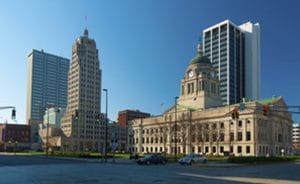Developers and construction companies adjusted to higher prices of commodities, such as lumber and steel, by postponing or halting projects. Some developers may have wished they had an alternate material or construction method with which to build to offset some construction costs. An up-and-coming construction method that may help reduce costs and speed up construction time is to 3D print the structure.
3D printing started in the 1980’s, when Hideo Kodama filed the first patent for 3D printing.1 Kodama’s system used UV light that hardened the material it hit to create objects. Various processes of 3D printing were developed over the decades leading to the ability to print with different materials, such as plastic, metal, wood, cement, and biological tissue. In 1999, the Wake Forest Institute of Regenerative Medicine 3D printed the first organ to be used for a transplant surgery.1
Some may think that 3D printing is just for making small parts and pieces. However, 3D printing has expanded with larger printers to build engines, shoes, boats, and houses. 3D printing technology could be beneficial to the real estate industry, with the construction of buildings. Various companies are experimenting with the technology around the world to build homes and office buildings. The materials they use to build can range from metal and concrete to rice, sand, and nearby earth.
Investors and developers of single-family rental houses and affordable housing would benefit from the speed and durability of a 3D printed house. ICON, a Texas-based developer, is doing just that. They built one of the first 3D printed homes in America. The CEO of ICON, Jason Ballard, says that using the 3D printing construction method is about 10% – 30% cheaper than traditional construction and several months faster.2 ICON was able to build a 600-800 square foot home in several days/weeks.3 With current 3D printing technology, only parts of a building are 3D printed, like the walls, but as the industry evolves, the percentage of the building that is 3D printed will grow.3 The lower costs and faster construction that 3D printing can bring mean a greater potential upside for investors and the possibility of more affordable housing for the tenant.
In addition to single-family houses, 3D printers can create office buildings. Gensler, an architecture and consulting firm, designed and Winsun Global, a development company, built the first 3D printed office building complex in Dubai. The building was printed in separate pieces in China and assembled on-site in Dubai, which cut the labor costs by 50-80% and cut construction waste by 30-60%.4 Costs and time will vary depending on location, size of the building, and proportion of the building that is 3D printed.
As 3D printing technology evolves, innovators will find ways to apply it to other types of buildings, such as industrial and retail properties. Companies are experimenting with alternate methods for 3D printing instead of using a robotic arm. Gensler conducted research on using an Unmanned Aerial Vehicle (UAV) / drone for 3D printing buildings.5 Other companies and research teams are experimenting with spider-like robots who work together to help build or monitor properties.6 The application of 3D printing in the real estate industry is relatively new and will change as developers and construction companies find ways to apply it to their business.
- https://www.asme.org/topics-resources/content/infographic-the-history-of-3d-printing
- https://www.cnbc.com/2021/03/12/3d-printed-housing-developments-suddenly-take-off-heres-what-they-look-like.html
- https://3dprint.com/261045/truth-in-3d-printed-construction-nobody-3d-printed-an-entire-building/
- https://www.architectmagazine.com/technology/gensler-designs-the-worlds-first-3d-printed-office-building-in-dubai_o
- https://www.gensler.com/doc/3d-printing-takes-flight
- https://www.architectmagazine.com/technology/these-3d-printing-bots-look-and-act-like-spiders_o


